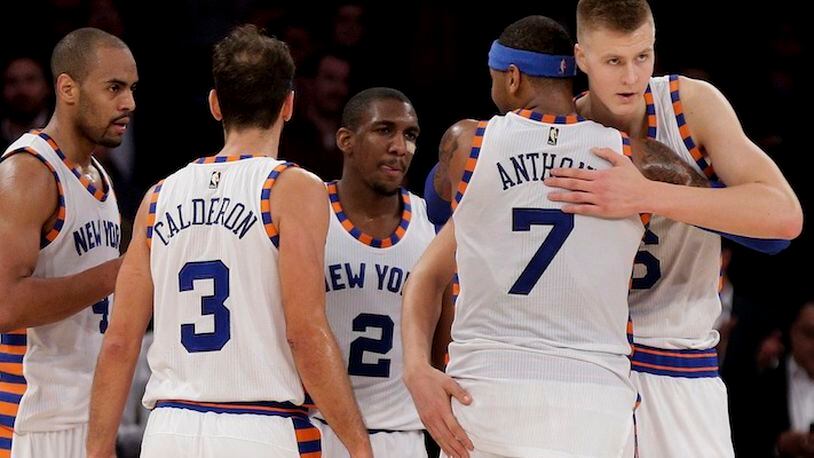“Lonnie Shelton — are you kidding me?” said Beard, a former teammate with the Knicks. “Heck of an athlete for a power forward. Six-foot-8, about 250 pounds, really strong, quick off his feet, could run like a deer.”
If there is any historical link to be made between Shelton and Porzingis on top of the swat show that helped the Knicks hold off the Dwight Howard-less Rockets in Houston on Saturday night, it is that both were athletically-enhanced big men, albeit several decades apart on basketball’s evolutionary chain.
If there is a lesson to be learned from the linkage, it is that the Knicks had better hang on to Porzingis for dear life, let him play, grow and presumably become the kind of franchise talent magnet that Carmelo Anthony was supposed to be.
That is, or should be, the early takeaway from an 8-6 team suddenly majoring in chemistry and engendering a whole lot of likability. A majority of this season’s games may still depend on the reliability of Anthony’s parabolic jump shot, but the franchise direction promises to be a straight vertical shot should Porzingis continue raising — figuratively speaking — the Latvian flag over Madison Square Garden.
In the fun — if pointless — pursuit of providing him a nickname to fit his meteoric rise, perhaps Dr. Zoom would suffice. And, yes, that’s a play on Marvel’s Dr. Doom, who did, after all, hail from the fictional nation of Latveria.
Projecting such accelerated stardom after 14 games may also be tempting the basketball gods to remind us of remaining hurdles — the opposition’s strategic adjustments and Porzingis’ durability over the long and winding season among them.
But if Porzingis is no tall tease, tell me how this coordinated and startlingly versatile 7-3 giant won’t eventually provide a curb appeal for the House of Dolan that is unparalleled, at least in the years since summer free agency turned into a reality game show of rewarding the most appealing plans for competitive prizes.
For as long as I have been critiquing the Knicks, from Porzingis all the way back to Shelton, they have usually done more overreaching and overpaying than actual sound planning.
Let’s start with the post-glory days, the late 1970s, when Spencer Haywood and Bob McAdoo were expensive acquisitions, the Anthony and Amar’e Stoudemire of their time, and about as complementary as Republicans and Democrats in Congress.
After one season of coaching these score-first frontcourt men, Willis Reed decided he needed a conventional center to do the fundamental, unsexy chores in the lane. Into the summer of 1978, he lobbied long and loud for the Knicks to open the vault for Marvin Webster, the so-called Human Eraser, who had defensively distinguished himself during the previous season’s playoff run by the Seattle SuperSonics to a seventh-game defeat (to Washington) in the NBA finals.
There was one problem. Signing Webster meant the league’s commissioner, Larry O’Brien, could award compensation to Seattle under old league rules. The Knicks wound up surrendering Shelton — their best young talent, who averaged 14.9 points and 7.1 rebounds in only 28.3 minutes per game as a second-year player — along with a first-round draft pick and cash.
Webster was never a vital piece in New York. Reed, Haywood and McAdoo were gone before the end of the 1978-79 season. Shelton assumed the starting power forward position in Seattle, allowing the more nimble and skilled Jack Sikma to slide over to center. The Sonics returned to the finals, where they dispatched the Bullets in five games.
The moral of that story: Relish those rare multidimensional talents, big or small, the players that cannot be put into one positional box.
That is even better advice for the 21st-century pro basketball architect, as Phil Jackson — a teammate of Shelton’s for his two seasons in New York — has embarked on the task of building a championship team, as opposed to coaching one.
Beard — a title-winning point guard at Golden State in 1975, a former assistant coach with the Knicks and head coach with the New Jersey Nets — lives in Harlem and has already seen enough of Porzingis, the No. 4 pick in the draft, to believe that his old friend Phil has already made what could well be his legacy-defining decision as the Knicks’ president.
Minnesota should be thrilled to have Karl-Anthony Towns, the first pick, but it is already obvious to Beard that the Los Angeles Lakers made a colossal mistake in taking point guard D’Angelo Russell at No. 2.
Of Jahlil Okafor, the No. 3 pick to Philadelphia, he said, “You can live with that because he’s going to score.” But Porzingis’ impact on Saturday night was felt inside and out, across the box score, with 24 points and 14 rebounds, in addition to the 7 blocked shots.
It moved Beard to rave, “This kid might wind up being the best one.”
Shelton, he agreed, was never really a star, merely a significant piece to Seattle’s championship puzzle. But what has impressed Beard about Porzingis is that he already appears to know that the sky’s the limit.
Interviewed at halftime by Rebecca Haarlow, he was asked how he had managed to make six of eight shots. Porzingis matter-of-factly mentioned his height and reach.
“That was smart, told me he gets it,” Beard said, meaning that “the kid is athletic, he likes contact” and, above all, he is bigger than everyone else.
About the Author
